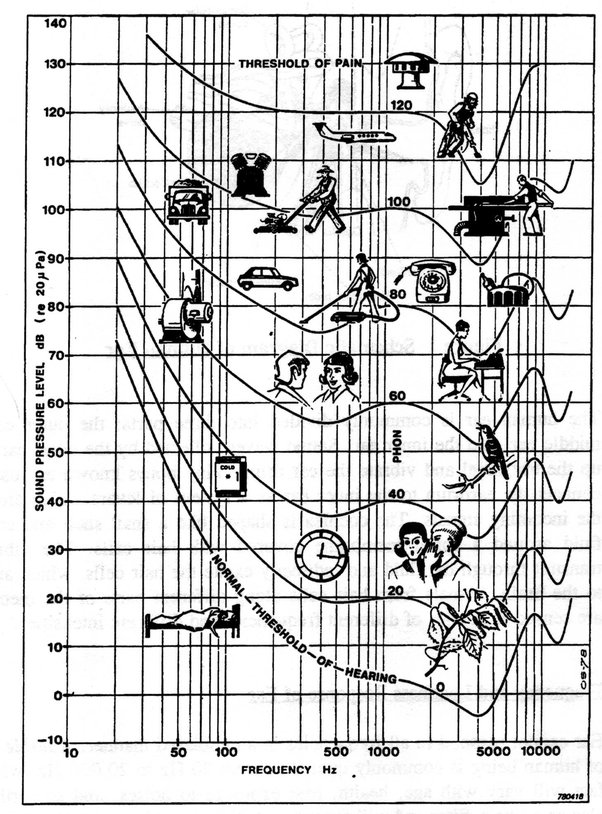How many sounds are possible
Highest audible beat frequency: 10 Hz (maximum different sounds one can hear in a second)
Range of frequencies: 20 kHz
Range of intervals: 10 octaves
Sound should also last between 0.004 to 0.013 seconds to be perceived, depending on the frequency. The average time is 13 ms. That would make for 100 possible notes in one second.
I can put this and beat frequency together to get 100 x 10 = 1000 possible sounds of a single volume and pitch in one second.
Discrete audible volumes?
A phon is the unit of perceptible audio intensity: https://courses.lumenlearning.com/suny-physics/chapter/17-6-hearing/
Wikipedia says the JND amplitude for humans is 1 dB.
There are about 120 phons till the threshold of pain. So I'll include 60 phons for music (also to account for frequency distribution)

Discrete audible intervals:
Some say 1/12th of a half-step (i.e. 8 cents)
Some say 0.5% of a frequency makes a noticable difference (and 1000-1002 Hz makes a perceptible difference)
Some say for low frequencies or high frequencies results may vary, but for human speech range, the results we may be able to tell apart 2-3 cents
5 cents is a good number to work with (1/40th of a cent). 25 cents would be it for an average adult (1/8th of a note / eight note / quaver).
There are 1200 cents in an octave.
1200 / 5 = 240.
1200 / 25 = 48.
- We have 1000 possible sounds of a same pitch and volume (tones and beats) in 1 second.
- We have at best 2400 different distinguishable notes across all 10 octaves.
- We can distinguish amplitudes of approximately 1dB, for about 60 distinct phons.
With this, there are 1000 x 2400 x 60 = 144,000,000 possible sounds in a second.
In 5 minutes, there are 144 million^300 possible sounds =
Resources
Related resource: https://en.wikipedia.org/wiki/Just-noticeable_difference
- The equally tempered scale ranges form 16-16000 Hz and has 120 tones
- The human perceptible range has 1400 notes.
- If notes are played together, the listener can distinguish them via their beat frequencies, increasing the number of notes.
24 tone equal-tempered (TET) tuning system has 24 notes per octave. This is also called 24-EDO (Equal Divisions of the Octave). Higher divisions exist, but are not commonly played unless the notes are adjacent to notice the differences. e.g. 31-tone, 34-tone, 41-tone, 53-tone, 58-tone, 72-tone, 96-tone.
The whole thing about tone intervals is called musical temperament. There are equal temperaments as well as irregular temperament scales.
The ear is remarkably sensitive to low-intensity sounds. The lowest audible intensity or threshold is about 10−12 W/m2 or 0 dB. Sounds as much as 1012 more intense can be briefly tolerated. Very few measuring devices are capable of observations over a range of a trillion. The perception of intensity is called loudness. At a given frequency, it is possible to discern differences of about 1 dB, and a change of 3 dB is easily noticed. But loudness is not related to intensity alone. Frequency has a major effect on how loud a sound seems. The ear has its maximum sensitivity to frequencies in the range of 2000 to 5000 Hz, so that sounds in this range are perceived as being louder than, say, those at 500 or 10,000 Hz, even when they all have the same intensity. Sounds near the high- and low-frequency extremes of the hearing range seem even less loud, because the ear is even less sensitive at those frequencies.
Source: https://courses.lumenlearning.com/suny-physics/chapter/17-6-hearing/
- XenHarmonic Wiki for musical tuning: https://en.xen.wiki/w/Main_Page
- Larger EDOs are for use in molecular physics, etc.
The largest physically possible EDO in a frequency range can be found through molecular physics such as the mean free path combined with the speed of sound in a given substance.
EDO vs ET: https://en.xen.wiki/w/EDO_vs_ET
You are exactly right in your conclusion that higher frequencies are harder to distinguish apart, due in large part to the non-linearity of frequency distribution in the cochlea.

Sound perception Notes: https://faculty.tamuc.edu/cbertulani/music/lectures/lec15/lec15.pdf
Also see: https://www.appstate.edu/~steelekm/classes/psy3203/Audition/Platt_chap1.htm
Related fields: Psychosomatics, Psycho-acoustics